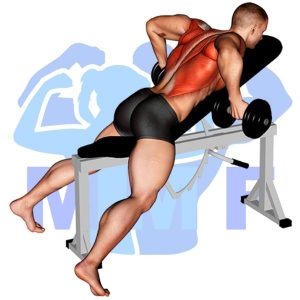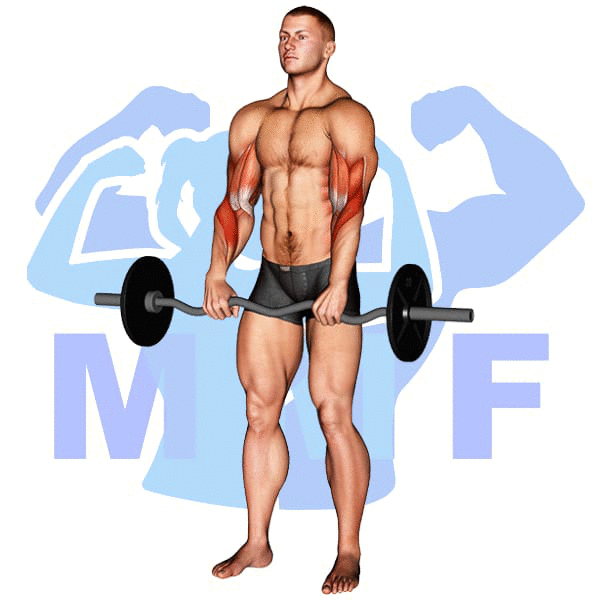Do you struggle with achieving sculpted, toned shoulders? Are you tired of using heavy weights and machines without seeing the results you desire? Reverse fly with bands is an excellent exercise that targets the rear delts, upper back, and helps to improve posture. The problem we often face is not having access to gym equipment, or having limited space in our homes. Don’t worry, you are not alone in this! With bands, you can effectively work on building your posterior muscles while creating a well-rounded and balanced upper body. In this blog post, I will provide step-by-step instructions on how to perform reverse fly with bands, so you can achieve the shoulder strength and definition you have been working towards.
Reverse Fly With Bands Summary
- Primary Muscles: Deltoid – Posterior
- Secondary Muscles: Deltoid – Lateral, Infraspinatus, Rhomboids, Teres Minor, Trapezius – Lower, and Trapezius – Middle
- Equipment: Resistance Band
- Mechanics Type: Isolated
- Force: Pull
- Utility: Auxiliary

Reverse Fly With Bands Instructions
- Get going by setting the center of the band on a wall or door anchor that this in front of your chest.
- Next grab the handles with your arms stretched out straight in front of your chest.
- Now, pull your arms out to your side with your back, keeping your arms straight.
- Then resist the bands as you allow them to pull your arms back forward.
- You have completed a single rep, repeat these reverse flys for a complete set of 8-12.
Video Tutorial
Reverse Fly With Bands Muscles
Target (Agonist)
Synergists
Dynamic Stabilizers
- None
Stabilizers
- Adductor Magnus
- Erector Spinae
- Gluteus Maximus
- Hamstrings
- Quadriceps
- Triceps Brachii
- Wrist Extensors
Antagonist Stabilizers
- None

Benefits of Reverse Fly With Bands
The Reverse Fly With Bands exercise is an excellent way to target the posterior deltoid muscles, which are a crucial part of the shoulder area. By performing this exercise, you can strengthen your posterior deltoids, improving their endurance and stability. This exercise can also help to maintain good posture and avoid shoulder injuries. Additionally, Reverse Fly With Bands can be done with minimal equipment and space, making it a great choice for those who do not have access to a gym or other specialized equipment.
Tips for Performing Reverse Fly With Bands
If you’re looking to get fit, the reverse fly with bands is an effective and time-efficient exercise to help you reach your goals. Not only will it help you build strength and tone your muscles, but it’s also a great way to improve posture and reduce back pain. Here are some tips to help you get the most out of your reverse fly with bands routine.
- If you can’t get an anchor directly in front of you can use a low point anchor, as long as your bend at your hips and keep your back straight so that our arms are perpendicular to your chest.
- To increase the resistance step farther away from the anchor point.
- Make sure that the bands are tight throughout the exercise and that each arm is feeling the same resistance.
Benefits and Tips Video
Frequent Mistakes To Avoid
Before attempting this exercise, it is important to be aware of common mistakes people make. To get the most out of the reverse fly with bands, and to ensure you stay safe and injury-free, it is crucial to avoid these mistakes. Let’s take a look at what not to do when performing this exercise.
- You Can’t Skip Out On Rest Days. Over-training could, in fact, make you weaker rather than bigger.
- Don’t relax your abs. Tightening your stomach protects your spinal column by maintaining your internal pressure.
- It Is Best If You Don’t Speed Through Your Exercise Routine. Every time you speed through your training session, you are more likely to use poor technique and injuries.
Find More Resistance Band Exercises Here
Variations and Complementary Exercises
If you are looking for additional exercises to add to your routine, here are some variations, complementary, and alternative exercises for the exercise Reverse Fly With Bands. These exercises will help target similar muscles as the Reverse Fly With Bands, allowing you to work the same muscles from different angles and further strengthen and tone them.
Seated V Bar Cable Row

The Seated V Bar Cable Row is an excellent complementary exercise for the Reverse Fly With Bands. This exercise helps to strengthen and build the muscles in the mid-back, shoulders, and biceps. This exercise can be done using either a cable machine or a V-Bar attachment. To perform the Seated V Bar Cable Row, sit on the edge of a bench and hold a V-Bar with both hands. Keep your back straight and engage your core. Pull the bar towards your chest while keeping your elbows close to your body. Slowly return to the starting position. This exercise is an effective alternative to the Reverse Fly With Bands, as it strengthens and builds the same muscles without requiring any equipment.
Underhand Dumbbell Row

The Underhand Dumbbell Row is an effective alternative to the Reverse Fly With Bands. It works the same muscles, but the added resistance of a dumbbell helps to increase strength and stability. The exercise is done by placing one hand on a bench, or other stable surface, and then holding a dumbbell in the other hand. The arm with the dumbbell is pulled back in an arc, as if rowing a boat, keeping the elbow close to the body. The back muscles are engaged throughout the motion, and the motion can be paused at the top of the movement for a greater challenge. This exercise helps to build strength in the upper back and shoulder muscles, helping to create a balanced physique.
Barbell Incline Row

The barbell incline row is an excellent complementary or alternative exercise for the reverse fly with bands. This exercise targets the same muscles as the reverse fly, but instead of using bands to provide resistance, a barbell is used. The barbell incline row is performed by lying on an inclined bench and pulling the barbell towards your chest. This exercise places more emphasis on the upper back, making it an effective alternative for those looking to target their back muscles in a slightly different way.
Check Out These Top Resistance Band Exercises
Barbell Rear Delt Raise

The Barbell Rear Delt Raise is an exercise that can be used to build strength and size in the rear deltoids. This exercise is performed by standing with your feet shoulder-width apart and gripping a barbell behind your back, palms facing forward. You then raise the barbell straight up to shoulder height and slowly lower it back down to the starting position. This exercise is a great alternative or complementary exercise to the Reverse Fly With Bands because it adds a different angle of resistance to the rear deltoids, thus allowing for a more complete training session. Additionally, the Barbell Rear Delt Raise can also help improve posture and stability due to the increased range of motion and core engagement during the exercise.
Dumbbell Rear Lateral Raise

The Dumbbell Rear Lateral Raise is an effective exercise for targeting the posterior deltoids, which are the muscles located at the back of the shoulder. To perform this exercise, stand with your feet hip-width apart and hold a pair of dumbbells at your sides with palms facing inward. Keeping your elbows slightly bent, raise your arms out to the sides until they reach shoulder height. Lower them back to the starting position and repeat. This exercise is a great complementary or alternative exercise for the Reverse Fly With Bands as it works similar muscles in a slightly different way. It can be used to build strength and stability in the posterior deltoids, helping to improve posture and upper body strength.
Incline Dumbbell Rear Deltoid Row

The Incline Dumbbell Rear Deltoid Row is a great complementary or alternative exercise to the Reverse Fly With Bands. This exercise works the same muscles, but in a slightly different way. The incline dumbbell rear deltoid row requires you to keep your arms slightly bent while pulling the dumbbells up, while the reverse fly with bands requires you to keep your arms straight. This exercise also allows you to use heavier weights, making it a great option for those who want to build more strength in their back and shoulder muscles.
Find More Back Exercises Here
Opposing Complementary Exercises
In addition to the Reverse Fly With Bands exercise, there are several other exercises that can be used to complement it. These exercises focus on working the opposing muscle groups, which helps to strengthen the body and create balance in the muscles. Below are a few of these exercises that work the opposite muscles.
Decline Dumbbell Twist Fly

The Decline Dumbbell Twist Fly is a great exercise to complement the Reverse Fly With Bands. By targeting the opposing muscle groups, the Decline Dumbbell Twist Fly works the posterior deltoids, while the Reverse Fly With Bands targets the anterior deltoids. The Decline Dumbbell Twist Fly also helps to stabilize the shoulder joint, improving shoulder stability and aiding in injury prevention. It is important to note that this exercise should be performed with a light weight and with proper form in order to maximize the benefits and reduce the risk of injury.
Dumbbell Fly

The Dumbbell Fly is a great complementary exercise to the Reverse Fly With Bands as it works the opposing muscle group. It involves lying on a flat bench with a dumbbell in each hand and arms extended above the chest. The arms are then lowered out to the side until the elbows are at about 90 degrees. The dumbbells are then squeezed back together and then returned to the start position. This exercise is great for building strength and size in the chest and front deltoids, which directly oppose the rear deltoids and upper back that are targeted with the Reverse Fly With Bands.
Incline Dumbbell Fly

The Incline Dumbbell Fly is a great complementary exercise to the Reverse Fly With Bands. It targets the same opposing muscle group, but in a different way. The Incline Dumbbell Fly focuses on the anterior deltoid, pectoralis major and minor, and the triceps muscles. This exercise is performed by lying on an incline bench with a set of dumbbells in each hand. The arms are extended straight out from the shoulders, then opened to the side and brought back together over the chest. This exercise provides an intense contraction of the chest muscles and can be used to further develop the strength and size of this muscle group.
Transform Your Upper Body with Reverse Fly: Take the First Step!
Do you want to transform your upper body but don’t know where to start? Look no further than the reverse fly! Adding this exercise to your routine can help strengthen your back muscles, improve your posture, and even alleviate neck pain. With the use of bands, you can easily modify the movement and tailor it to your fitness level. Don’t be afraid to try something new- take the first step towards a stronger upper body today!
References: Wikipedia | ExRx.net | PubMed.gov | Comprehensive List of Back Resistance Band Exercises




